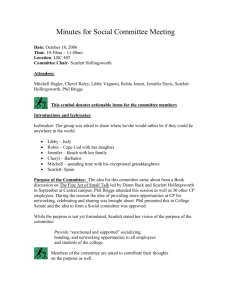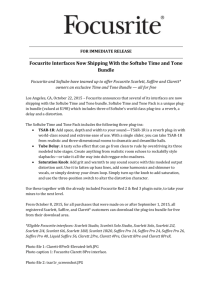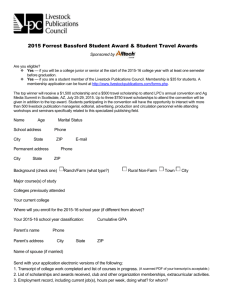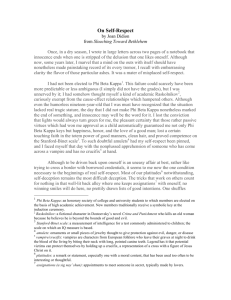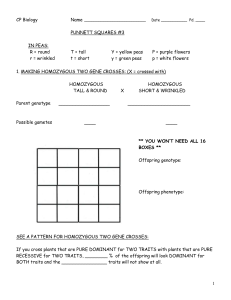Gone With The Wind (1939) - Northern Illinois University
advertisement
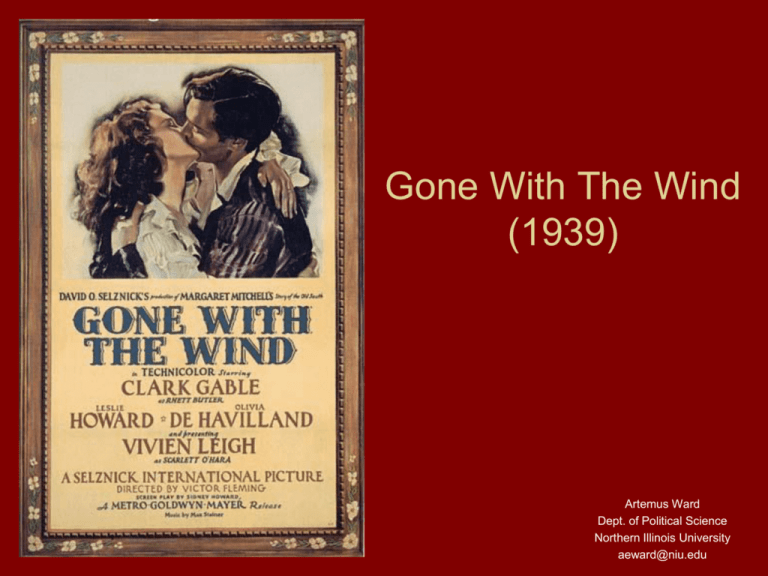
Gone With The Wind (1939) Artemus Ward Dept. of Political Science Northern Illinois University aeward@niu.edu Introduction • Despite longstanding history that accurately portrays slavery based on slave narratives (Rawick 1972), the reasons for the South losing the war (Beals 1965), and Reconstruction (Bennett 1969), Americans continue to think about the past not based on fact but instead based on myth: images gleaned from the mass media and particularly films. • Because of its longstanding popularity and acclaim, Gone With the Wind (GWTW), is perhaps the single most damaging, ongoing portrayal of these events. For many people the film is the main way in which the Civil War is remembered. • One need ask only one question to see how incomplete and inaccurate the film is: • Does Mammy or any other black character in the film have any family? Margaret Mitchell • Mitchell began writing the novel in 1926. It was published in 1936 and won the Pulitzer Prize the following year. • Mitchell’s novel is southern plantation fiction, also known as anti-Tom literature, written as a pro-slavery response to such popular anti-slavery literature as Uncle Tom’s Cabin. • Southern plantation fiction is written from the perspective and values of the benevolent slaveholder and presents slaves as docile and happy. • It is the second favorite book by Americans, just behind the Bible, according to a 2008 Harris Poll. • The poll found the novel has its strongest following among women, those aged 44 or more, both Southerners and Midwesterners, both whites and Hispanics, and those who have not attended college. • The novel is on the list of best-selling books, selling more than 30 million copies. Mythmaking • Gone With the Wind (GWTW) is an archetypal statement of the myth of the “Old South”: – – – – – the columned plantation house white women on pedestals carefree field hands devoted house slaves the “carpetbaggers and scalawags” myth of Reconstruction • GWTW shows the South as it never was, emphasizing Southern honor and Yankee imperialism. Plantation Myth • Most southerners were not slaveholders, not wealthy, and did not live in mansions. • Most whites who owned slaves owned fewer than five. • The homes of most people that did own slaves were so modest that when researchers for Gone With The Wind went looking for archival photos or descriptions of sprawling manor houses with verandas and white columns in Georgia, they had to report that they could not find any. • Margaret Mitchell said: “I made up Tara, just as I made up every character in the book. But nobody will believe me.” Slave-Era Stereotypes • Although black women have been featured in U.S. cinema since the early days of silent films—in The Wooing and Wedding of a Coon (1905) and The Masher (1907), for example—the basic representational paradigm governing their image has changed little. • They have served primarily as white women’s Other, a dark continent of difference whose various lacks—of beauty, morality, and intelligence—subtend the cultural elevation and adornment of white womanhood. – mammy or maid in Gone With the Wind (1939), Pinky (1949), Such Good Friends (1971), and The Help (2011); – seductress in Hallelujah (1929), Porgy and Bess (1959), Carmen Jones (1954), and Angel Heart (1987); – matriarch in A Raisin in the Sun (1961), Big Momma’s House (1992), and The Matrix (1999); – whore in Anna Lucasta (1959), Take a Giant Step (1961), The Pawnbroker (1965), The Hit Man (1972), or Monster’s Ball (2001); • These stereotypes, drawn and nourished in the slave era, effectively exclude black women from cultural notions of the feminine—and exclusion that ironically provides the structural basis for such cultural articulations. Slave Hierarchy • The film portrays the differences between the house servants such as Mammy and Pork and the field hands such as the foreman Big Sam. • The house slaves appear comparatively well off and it is only the field slaves who leave the Tara plantation after the Emancipation Proclamation (1863). • The novel explains that the field hands behave "as creatures of small intelligence might naturally be expected to do. Like monkeys or small children turned loose among treasured objects whose value is beyond their comprehension, they ran wild—either from perverse pleasure in destruction or simply because of their ignorance." • Of the servants that stayed on at Tara, Scarlett thinks to herself, "There were qualities of loyalty and tirelessness and love in them that no strain could break, no money could buy." Ku Klux Klan • Does the film ever mention or portray the KKK? • When producer David O. Selznick received screenwriter Sidney Howard's first fifty-page draft of the script, Selznick deleted all references to the Klan. • Yet the film not only shows Klan activity it also glorifies it. How so? • After Scarlett narrowly escapes from the shanty town with the help of Big Sam, her husband Frank Kennedy and the Ku Klux Klan raid the shanty town whereupon Frank is shot dead. • In order to keep the men from being arrested by the Union Army (the south is under martial law during Reconstruction), Rhett puts on a charade by pretending to be drunk. He claims that he and the other men had been at Belle Watling’s brothel that evening and the Yankees buy it. • Hence the KKK is a noble organization that protects the honor of its people and bests the Union Army. The Wind Done Gone (2001) • • • • • • • Alice Randall’s novel was a controversial response to the historical fiction of Margaret Mitchell’s Gone With The Wind. Randall's main character Cynara narrates this book through journal entries, giving the reader the opportunity to examine the grittier aspects of slave society (the unacknowledged alliances and relationships between men of power and colored women, the unrecognized mixed-race mulatto children, slave markets, jealousy and manipulation) and the similarities of all people, irrespective of race (love, loss, and longing). In Randall's South, slaves aren't childish simpletons but clever manipulators with much more depth and texture of character than Mitchell allowed them in her portrayal of a South without racial brutality and miscegenation. The slave-master relationship depicted in Mitchell's work is sharply ridiculed by Randall throughout her novel. On the surface, Mitchell's account shows a family in full command of riches, power, land and slaves. In Randall's portrayal, it is the slaves who truly maintain control of the family's destiny. From the marriage of the family's parental units, to the design of the house they will live in, to the day to day management of the estate, Mammy and Pork remained in subtle yet assured control. Keepers of secrets and masters of manipulation, they created and secured a present and future ("What would we a done with a sober white man on the place?") that ensured safety and shelter in an atrociously oppressive environment. Vivien Leigh as Scarlett O’Hara • The southern belle is an archetype for a young woman of the American old south upper class. The southern belle's attractiveness is not physical beauty, but rather lies in her charm. • While Scarlett is at once the quintessential southern belle, she also rebels. • Scarlett's bad belle traits, her deceitfulness, shrewdness, manipulativeness, and superficiality, in contrast to Melanie's good belle traits, trust, self-sacrifice, and loyalty, enable Scarlett to survive in the post-war south, and pursue her main interest, making money. • Like all white women of the era, Scarlett’s goal is to marry in order to maintain and improve her social and financial status. She marries not once was but three times: Charles Hamilton, Frank Kennedy, and Rhett Butler. • In the novel she has a two children before Bonnie: Wade Hampton Hamilton (son to Charles Hamilton) and Ella Lorena Kennedy (daughter to Frank Kennedy). Cynara “Cinnamon” Cindi • Cynara is Scarlett O'Hara's half-sister, the child of Scarlett’s father, Gerald O'Hara, and Mammy. • Cynara was raised side by side with Scarlett and as children both sisters competed for the attentions of Mammy. • As adults they continued their competition this time for the love of the same men, first Ashley Wilkes and later Rhett Butler. • Cynara's diary of life as a mulatto at Tara and during Reconstruction reveals jealousy, resentment, hypocrisy, well-guarded family secrets, and personal redemption. • She writes of her transformation from resentful slave to independent-minded woman. Thomas Mitchell as Gerald O’Hara • • • • • • White slaveholding plantation owner of Tara. Captain in the state militia and leader in the community. TWDG: His passion is for Mammy, not for his wife. Father to Cynara, Scarlett O'Hara's half-sister, with Mammy. Though he doted on his daughter Cynara when she was young, he sells her away from her home to another family when he realizes that she is Scarlett’s rival and that she would inevitably end up as a bedmate for Scarlett’s husband. • Yet, through a twist of fate, Cynara ends up working for Belle Watling, begins a relationship with Rhett, tells him about Scarlett, and unwittingly leads Rhett to her. Hattie McDaniel as Mammy • • • • • • • • • Mammy is a slave who originally belonged to Scarlett's grandmother, and raised her mother, Ellen O'Hara. She is a loyal house servant and protector to Scarlett and her sisters. She remains loyal to the family even after the Emancipation Proclamation (1863) and during Reconstruction. In the novel she recognizes her freedom to come and go as she pleases saying, "Ah is free, Miss Scarlett. You kain sen' me nowhar Ah doan wanter go.“ Yet she never leaves Scarlett. TWDG: Wet nurse and mother-figure to the white children of Gerald O’Hara and biological mother to the mulatto children of Gerald O’Hara. She gained weight in order to make herself sexually undesirable to her white master. Mammy favored her surrogate white children over her biological offspring. Mammy’s masters believe she is a loyal slave, but the other slaves suspect that she killed Scarlett’s mother and Gerald O’Hara’s male children—given to her to nurse—so that Mr. O’Hara would be Tara’s last white master. Barbara O’Neil as Ellen O’Hara • Scarlett's gracious mother of French ancestry, Ellen married Gerald O'Hara, who was 28 years her senior, after her true love, her cousin Phillipe Robillard, was killed in a bar fight. • Ellen ran all aspects of the household and nursed negro slaves as well as poor white trash. • She dies from typhoid in August 1864 after nursing Emmie Slattery. • TWDG: • Hurt by the close relationship between her eldest daughter Scarlett and Mammy, she would sometimes nurse Cynara. • She kept a secret that could destroy her family: she learned that one of her distant ancestors was black, which by the One-drop rule made her and her children Negro. Therefore, like many mixedrace persons, she worked hard to “pass” as white and explains why she nursed slaves. Clark Gable as Rhett Butler • Born to a respected family of Charleston, Rhett was expelled from West Point and disinherited by his father when he refused to marry according to the latter's wishes. He made his own fortune in the California Gold Rush of 1848-1849. • Rhett has a reputation as a womanizer, scoundrel, and scallawag. A scallawag is a loafer, vagabond, or rogue and the term had special meaning after the Civil War as an epithet for a white Southerner who willingly accepted the reforms by the Republicans. In the novel, Mitchell defined Scallawags as, "Southerners who had turned Republican very profitably.“ • He redeems himself in the eyes of southerners when he becomes a blockade runner, joins “the cause”, and marries and buys his way into “respectable” society. • He ultimately leaves Scarlett when she refuses his sexual and familial advances. • At the end of the novel, Rhett confesses to Scarlett, "I loved you but I couldn't let you know it. You're so brutal to those who love you, Scarlett." • Margaret Mitchell was asked what happened to Scarlett and Rhett and she said that she did not know: "For all I know, Rhett may have found someone else who was less difficult.” Rhett Butler: TWDG • TWDG: • Cynara sees Rhett as a prize that she can win in her rivalry with her half-sister Scarlett. • Cyn becomes Rhett’s mistress when he leaves Scarlett after the death of their daughter Bonnie. • Rhett purchases her off the auction block, takes Cynara as a mistress and kept woman, sets up house with her, and later marries her. • While Rhett loves Cynara for her beauty, he never tries to understand her and ultimately Scarlett’s ghost is always between them. • Furthermore, throughout their relationship, Cynara is torn between two loves. A love she feels owed to Rhett for "rescuing" her from a life of toil (only to imprison her to a life of domestic servitude) and the love that is awakened in her upon meeting a black Congressman during a visit to Washington, DC. Leslie Howard as Ashley Wilkes • The unobtainable knight of Scarlett’s dreams. • He chooses to marry his plain cousin Melanie Hamilton and live respectably. • He says he would have freed his slaves after his father's death, if the war hadn't done it first. • In Mitchell’s novel Rhett calls him "Dead Sea fruit" which is defined as "something that appears to be beautiful or full of promise but is in reality nothing but illusion and disappointment." • TWDG: • Because he is gay he is continually horrified by Scarlett’s advances. • He secretly loves Prissy’s brother, a slave. • When his lover revealed the affair to his wife, Melanie, she had the slave whipped to death. Olivia de Havilland as Melanie Hamilton Wilkes • Raised by her Aunt “Pittypat” Hamilton Melanie marries her cousin Ashley and eventually becomes best friends with Scarlett. • Like her brother and parents, Melanie is prone to sickness due to generations of “inbreeding” between the Hamilton’s and the Wilkes’. • As the story unfolds, Melanie becomes progressively physically weaker, first by childbirth, then "the hard work she had done at Tara," and she ultimately dies after a miscarriage. As Rhett Butler said, "She never had any strength. She's never had anything but heart." • In the novel, Melanie objects to her husband's intended move to New York because it would mean that their children would be educated alongside Yankees and pickaninnies. Ona Munson as Belle Watling • The stereotypical prostitute with a heart of gold, Belle helps the South by donating money to the cause. • A brothel owner, she once owned Cynara, which is how Rhett came to be involved with the O’Hara’s. • She is a source of advice for the young woman. • Although she had an affair with Rhett, Cynara believes she is a lesbian. Oscar Polk as Pork • Gerald O'Hara's valet and the first slave he owned. According to the novel, Pork was won in a game of poker (as was the plantation Tara). • When Gerald died, Scarlett gave his pocket watch to Pork. She wanted to have the watch engraved with the words, "To Pork from the O'Hara's— Well done good and faithful servant," but Pork declined the offer. • The novel depicts Pork’s wife Dilcey, a slave of mixed Indian and African descent. Scarlett pushes her father into buying Dilcey and her daughter Prissy from John Wilkes, the latter as a favor to Dilcey that she never forgets. • TWDG: • Gerald’s manservant Pork is the architect of his master's success, his master's marriage and the house Tara. • He used his wits and patience to manipulate O’Hara, with the goal of becoming the estate's real master. Indeed the GWTW scene where Scarlett and Pork discuss taxes suggests this. • Cynara suspects that he may also be the mastermind behind Gerald O’Hara’s death. Butterfly McQueen as Prissy • • • • • • • A child pickaninny slave girl, the daughter of Pork and Dilcey. When Scarlett and Prissy arrive in Atlanta with Scarlett’s baby from her first marriage to Charles, Uncle Peter negatively calls Prissy a pickaninny in his explanation for why Aunt Pittypat and Melanie are not there to meet them: "Miss Pitty in a state bekase she din' come ter meet you. She's feared you mout not unnerstan' but Ah tole her she an' Miss Melly jes' git splashed wid mud an' ruin dey new dresses an' Ah'd 'splain ter you. Miss Scarlett, you better tek dat chile. Dat lil pickaninny gwine let it drap.“ When Melanie is going to give birth Prissy first says that she can do it and later says that she cannot: “Oh, lawdsy, Miss Scarlett! Lawdsy, we've got to have a doctor! I don't know nothing about birthing babies. I don't know how can I tell such a lie. Ma ain't never let me around when folks was having them.” TWDG: She holds a grudge against Melanie Wilkes, whom she blames for two of her brothers' deaths. One of her brothers was whipped to death when Melanie discovered his affair with her husband. The other starved to death as a baby when his mother became wet nurse to Melanie's child Beau. The whites believe she was psychologically broken by her brothers' deaths, but the slaves believe that she is a crafty woman who is responsible for Melanie’s death. Aftermath • The film won many awards and is routinely listed on film critics’ lists of the best films of all time. • Hattie McDaniel, who played Mammy, won an Academy Award for Best Supporting Actress – the first African-American honored by the Academy. • McDaniel was also an accomplished singer and was the first African-American to sing on the radio. • She has two stars on the Hollywood walk of fame. Conclusion • Until the 1970s, Americans who sat in the movie theaters saw an endless string of Civil War films in which African Americans were mostly depicted as groveling simpletons, as in Gone With The Wind, or, murderers and rapists, as in The Birth of a Nation. • Movies convinced many whites that the disgraceful way in which blacks had been treated in and out of slavery over the decades was perfectly justified. If slaves occupied the very lowest regions in the reel world, put there by supposedly well-researched Hollywood films, it followed that they should occupy it in the real world, too. Ultimately, Civil War films showed Americans that they could be reunited after the end of the war – reunited in their whiteness. References • • • • Beals, C. 1965. War Within a War (Philadelphia: Chilton). Bennett, L. 1969. Black Power U.S.A.: The Human Side of Reconstruction (Baltimore: Penguin). Pilgrim, David. 2002. “Jezebel Stereotype.” Jim Crow Museum of Racist Memorabilia. Rawick, G. 1972. From Sundown to Sunup: The Making of the Black Community (Westport, CT: Greenwood).
